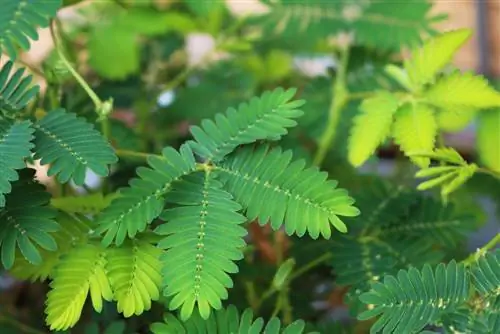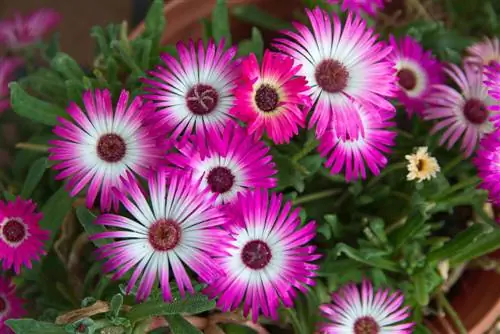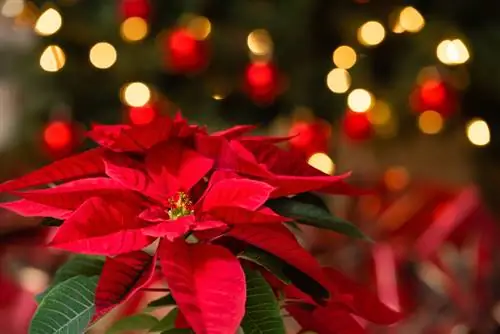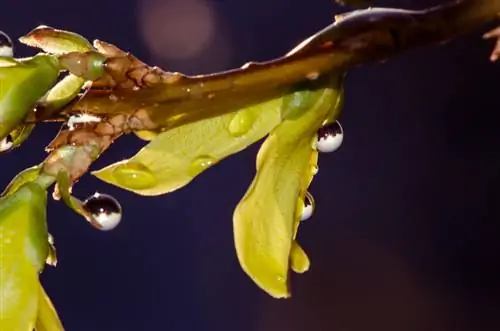- Author admin [email protected].
- Public 2024-01-02 03:03.
- Last modified 2025-06-01 06:02.
The mimosa, which comes from warm, tropical South America, is rarely cultivated as a houseplant in this country, even though it is not called the “shameful sensory plant” without reason and its plant name has even become a synonym for “sensitive”.. The pretty plant is easy to care for over the summer, but difficult to overwinter.
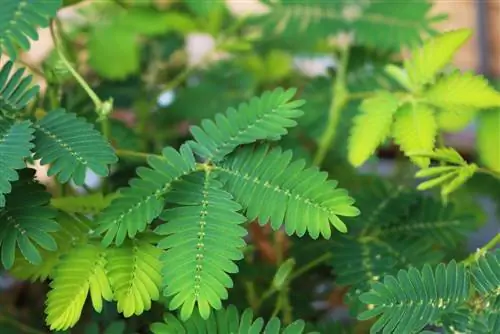
What is a mimosa?
The mimosa is a plant from South America that is known here as a houseplant. It gets its name from its sensitive reaction to touch. At the slightest stimulus, the leaflets fold together. The mimosa is not hardy and grows to a height of 30-50 cm.
Origin and distribution
With the term “mimosa”, the gardener usually means Mimosa pudica, which is the only one of the approximately 500 species of mimosa family (Mimosoideae) that is cultivated as a houseplant. The pretty plant is native to the tropical and subtropical regions of South America, but has also spread invasively to other parts of the world. For example, mimosas are often found in southern European countries. The genus belongs to the family Leguminosae (butterfly flowers or legumes).
Characteristics
Mimosa is famous for its peculiar reaction to touch, which is why sensitive people are still referred to as “mimosa” to this day. The delicate pinnate leaves of the plant fold up within a few seconds at the slightest stimulus, with even the petiole lowering downwards. Occasionally the plant will perform a kind of chain reaction when several leaves and shoots react in this way. The leaves only unfold again after about half an hour.
Interestingly, mimosas only react in the way described when touched by a foreign object, a human finger or even heat, but not to drafts, wind or movements of their own stems and leaves. Of course, it's especially fun for children to play with the "scaredy" plant in this way, for example by touching it or even holding a lit match under the leaves and then observing the reaction. However, since this requires a lot of energy from the mimosa, you should not carry out the touch test too often. After a while, every plant suffers massively from the stress, and some varieties do not react so quickly and only recover slowly.
Usage
The mimosa is not hardy and is therefore only used as a houseplant. The so-called gardener's mimosa or false mimosa, on the other hand, is the silver acacia (Acacia dealbata), which is a frost-sensitive deciduous tree that comes from Australia. Both species belong to the legumes and are therefore related to each other.
Appearance and growth
The Mimosa pudica, which is kept indoors, is a small, woody subshrub that grows about 30 to 50 centimeters high. Typically, the herbaceous plant has a mostly naked, sometimes bristly trunk that is more or less branched and occasionally has spines. The early, sparse growth and the difficult overwintering ensure that the actually perennial plant is mostly cultivated as an annual.
leaves
The mimosa is particularly attractive thanks to its long-stemmed and double-pinnate leaves, each of which has between ten and 26 leaflets. These in turn are sessile, elongated and pointed to rounded. Stipules that are around seven to eight millimeters long also grow on the plant. Typically all leaves and leaflets are slightly bristly. The characteristic movements of the leaves, which the botanist calls nastia, are caused by various stimuli and these are used to protect the plant. The mimosa reacts to shocks and a change in the ambient temperature, but also to a change in light intensity. Leaf movements are usually no longer present at temperatures below 18 °C or at night, especially since the mimosa goes into the so-called “sleeping position” in the dark.
Flowers and flowering time
Between July and October, the mimosa continuously produces spherical, pink to purple flower heads that remind the viewer of dandelions. The pretty flowers are always at the end of the branches and fade after a maximum of two days. However, the plant constantly produces new flowers.
Fruits
After flowering, flat and articulated legumes up to two centimeters long and five centimeters wide are formed. These are light green when ripe and also have a bristly and prickly surface to protect them from predators. The fruits contain flat, hard and brown seeds that are only three to four millimeters in size. Mimosa can only be propagated using these seeds.
Toxicity
The mimosa is not directly classified as a poisonous plant because it contains only a few toxins. However, you should place the houseplant in a location where curious children and pets cannot access it unattended. The slightly toxic ingredients do not cause any harm to he alth, but can still lead to discomfort and nausea.
Which location is suitable?
The mimosa feels most comfortable in a bright spot without direct sunlight. Temperatures between 18 and 20 degrees Celsius are also optimal. During the summer months you can also place the plant outdoors in a sheltered location, but not in full sun. Whether inside or outside: the space must be free of drafts, the temperatures must be stable and there must be little traffic, for example because someone is constantly walking there. Such a location prevents the leaves from constantly folding up from the outset and thus protects the plant's energy reserves. However, the mimosa is not suitable for growing in a shady spot.read more
Substrate
Since mimosas are usually only cultivated as an annual, a so-called standard soil is usually sufficient. However, pay attention to quality: Compost-based potting or planting soil is not only he althier for the environment than a cheap, peat-based substrate (after all, the peat does not have to be broken down with the destruction of valuable habitats), but also ensures a better water balance in the soil Pot. Peat hardens quickly and is then no longer able to absorb water. Compost, on the other hand, is both a good water reservoir and permeable enough to allow excess irrigation water to flow through.
Advance
From March you can make the pretty mimosas yourself. You can either get the seeds you need in stores or get them from your own harvest from last year. However, in order for some mimosa flowers to produce fruit, you must put the plant outside during the summer months. Only here can insects in search of food carry out the necessary pollination. Then do not cut off the withered shoots, but leave them standing. The small legumes form here until autumn and you finally pick them off. Remove the seeds inside and keep them dry, cool and tightly closed over the winter.
If you finally want to sow the hard-shelled seeds, first let them soak in a warm place for at least twelve hours. In the meantime, fill a shallow growing tray or small pots with a nutrient-poor growing substrate or cocohum, having previously sterilized the substrates in the microwave or oven. This is important because otherwise the sensitive seeds will become moldy. Plant the seeds and do not cover them with soil, as mimosas are light germinators. Keep the substrate slightly moist and cover the cultivation containers with a translucent cover, such as cling film or a PET bottle from which you have cut off the top part with the bottle neck.
The pots should be kept warm at temperatures between 20 and 25 °C and in a bright place, avoiding direct sunlight. Ventilate daily to prevent mold from forming under the cover. Once the seedlings have developed three to four pairs of leaves, transplant them into individual pots. It is important, especially when growing in cocohum, to start fertilizing early.
Planting and repotting
You don't need to repot mimosas that have only been cultivated as annuals, unless you put the young seedlings in a flower pot with real potting soil for the first time. You should also move newly purchased plants straight away, as in many cases the pots are too small and/or the substrate is moist or already exhausted. Otherwise, only perennial specimens require fresh soil and a new planter from time to time. Ideally, you should repot in spring.
It's high time to repot when the roots of the mimosa grow out of the pot and/or the root ball completely fills the planter. The plant's roots need space to grow, but you shouldn't make the pot too generous. In a smaller pot, the plant looks more decorative and often blooms more profusely. Much more important is the large drainage hole at the bottom of the pot, through which excess irrigation water can drain away. This is how you prevent waterlogging in the first place. How to plant the mimosa:
- Carefully lift the plant out of the old planter.
- Shake off the adhering soil lightly.
- Check the roots.
- Cut away rotten and diseased roots.
- Fill a fresh pot with a drainage layer and some substrate.
- Expanded clay or some clay shards are suitable for drainage.
- Place the mimosa in the pot and fill in the soil around it.
- Press the substrate gently.
- Pour the mimosa.
If you have used pre-fertilized standard soil, you do not need to fertilize the mimosa for the first four to six weeks. However, place the plant in a warm and bright location without direct sunlight.
Don't be surprised if the mimosa looks a bit ragged after repotting. This process always means stress for the plant, which is why it appears a bit worn out afterwards. However, with good care and plenty of rest, she usually recovers quickly.
Watering mimosa
There are exactly two things that mimosas don't like when it comes to watering: moisture and dryness. The sensitive plants cannot tolerate waterlogging or dry root balls, which is why you should always keep the substrate evenly moist with great sensitivity. Before watering again, always do a finger test and only water the mimosa when the surface of the substrate has already dried. Any excess water that has run into the saucer or planter must be removed immediately to avoid waterlogging.
The mimosa is not very lime tolerant and should therefore be watered with soft water - preferably rainwater, alternatively well-stagnant tap water. What is even more important is the right humidity: tropical plants need high humidity, which is best achieved by setting up water bowls. Incidentally, low humidity in the ambient air is disastrous for plants, especially in winter, especially since there is a risk of spider mite infestation in dry conditions.read more
Fertilize mimosa properly
After repotting in spring, you do not need to fertilize the mimosa immediately. Only older plants are happy about occasional fertilizer applications, although they only have a low nutrient requirement and therefore need little fertilization. It is sufficient to supply the plants with a liquid green plant fertilizer about once a month, which you administer together with the irrigation water and only mix with half the dose recommended by the manufacturer.
Cut mimosa correctly
Since mimosas do not tolerate pruning well, you should avoid pruning the plant. She often reacts offended and then doesn't act out anymore. Incidentally, this is also one of the reasons why mimosas are usually only kept as annuals: older plants in particular grow quite sparsely, which doesn't always look attractive. At the same time, they cannot be shaped with the help of scissors.read more
Propagate mimosa
It is better to reseed the mimosa every year. By the way, sowing is also the only way to propagate this interesting houseplant. In principle, propagation through cuttings is possible, but it is fraught with various problems: On the one hand, the mother plant tolerates pruning poorly and, with a bit of bad luck, will subsequently die. Secondly, the cut shoots root very poorly and then have to survive the winter. If you still want to try it, the following tips will give you the best chance:
- Cut cuttings only before flowering in spring or early summer.
- There may still be flowers or just flower buds to be seen.
- After flowering begins, the rooting rate drops drastically again.
- This also applies if you remove flowers and buds from the cuttings.
- Pluck off the lowest leaves.
- Place the shoot in a glass of water.
- Place this in a warm and bright place.
- This should be quiet and free from drafts.
Plant the cutting as soon as the first roots appear. If you wait too long, the plant will die quickly - it is usually too moist for it. To improve root development, you can dip them in a rooting substrate before planting.read more
Wintering
Since mimosas no longer look too beautiful with age and caring for them in winter is quite tricky, you should refrain from overwintering them. It is better to grow new plants from seeds in spring. If you still want to try it, you should place the plants in a bright place, but relatively cool at around 18 to 20 °C - the windowsill in the living room with the heater underneath is an unsuitable location, especially since the heating air also removes the necessary high humidity. Water the plant sparingly in the winter months, but keep the humidity high. Stop fertilizing completely until next spring.
In winter, plants often shed their leaves because it is simply too dark for them. You can counteract this phenomenon with lamps or special plant lighting.read more
Diseases and pests
Even if most people instinctively suspect otherwise: mimosas are surprisingly resilient when it comes to diseases and possible pest infestation. They rarely get sick or are attacked by pests. However, if the plant doesn't really want to thrive or doesn't develop flowers, care errors or an unsuitable location are usually the cause. Shoot and root rot most often occurs as a result of excessive watering. This disease is manifested by yellow leaves. As a rule, overwatered plants die, but sometimes you can save them by quickly repotting them in dry substrate.
If the ambient air is too dry, spider mites (also: red spiders) often attack the mimosa. You can recognize the infestation by the fine webs, which often only become visible when sprayed with water mist. Here too, the tiny spider mite, which is barely visible to the naked eye, initially shows itself through yellowing of the leaves. If you carefully shower infected plants and increase the humidity, the pests will often go away on their own. If you have a stubborn infestation, you can use commercially available products that you simply stick into the substrate.
Mimosa loses its leaves, what to do?
When mimosas drop their leaves, there are various reasons behind it. It may be that your plant's location is too dark or too light, too warm or too cold or simply too drafty. Furthermore, incorrect watering can result in leaf loss if the plant is permanently too moist or too dry. All of these causes are out of the question: Even touching the leaves too often will eventually cause them to fall off because the mimosa cannot compensate for this effort in the long term. In general, the leaves of the houseplant are very sensitive: the mimosa cannot tolerate poor air quality either. For example, it quickly disappears in smokers' rooms. Create suitable location conditions for the mimosa, water it according to the instructions described above, don't touch it too often and don't smoke in its presence - then nothing should stand in the way of a he althy, beautifully leafed and flowering plant.
Tip
Even if mimosas occasionally look similar to small bonsai due to their sometimes peculiar growth, they are not suitable for a bonsai culture. They cannot be forced into a desired growth habit and are also difficult to overwinter.
Species and varieties
Of the approximately 500 different species of the mimosa family, we only cultivate the species Mimosa pudica as a houseplant. However, adult plants are rarely available commercially, which is due to the sensitivity of the “Rührmichnichtan” - the slightest vibrations and differences in temperature and light cause the leaves to collapse and weaken the plant. As a rule, you have to grow Mimosa pudica yourself from seeds that you can get from garden shops. There is no distinction between different varieties.

